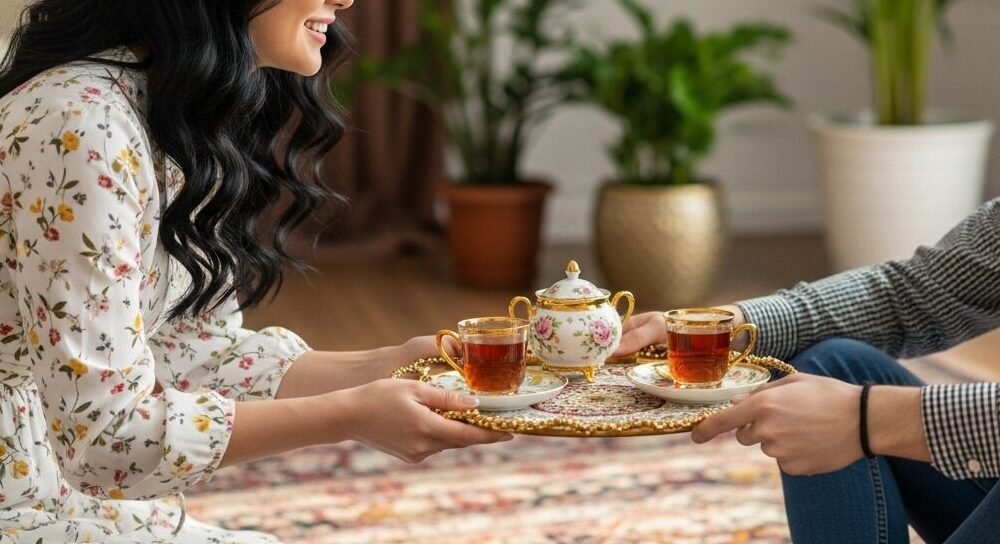
Stylish Tea Trays: Elevate Your Tea Time with the Perfect Tea Tray
Index
Finding the right surface for your tea brewing can make or break your daily ritual. Tea trays have been used for centuries across the world as essential tools for both practical brewing and artistic display.
A good tea tray catches spills, holds your teaware securely, and creates a defined space for your tea practice. Your tea moments deserve this upgrade.
Key Takeaways
- Tea trays serve both practical and artistic roles in tea culture, catching spills while creating a dedicated space for mindful brewing.
- Bamboo remains the most popular material for tea trays due to its lightweight design (1.2 kg/ 2.6 pounds), large water capacity (2100 ml), and natural resistance to moisture damage.
- Different cultures use unique tray styles – Chinese Gongfu ceremonies rely on drainage-equipped Cha Pan trays, while Moroccan traditions showcase ornate metal trays as symbols of hospitality.
- Proper care extends tray life – keep bamboo away from direct sunlight, empty reservoirs promptly, and clean with dry gauze rather than soaking in water.
- The right tray matches your brewing style, with elaborate drainage systems for “wet” brewing methods and simpler surfaces for casual tea sessions.
The Essential Role of Tea Trays in Tea Culture
Tea trays serve as the foundation of any proper tea ritual, offering both function and beauty to the brewing process. These essential platforms do more than hold your teapot—they create a dedicated space that transforms simple tea drinking into a mindful practice.
Defining the Tea Tray: Cha Pan and Cha Chuan
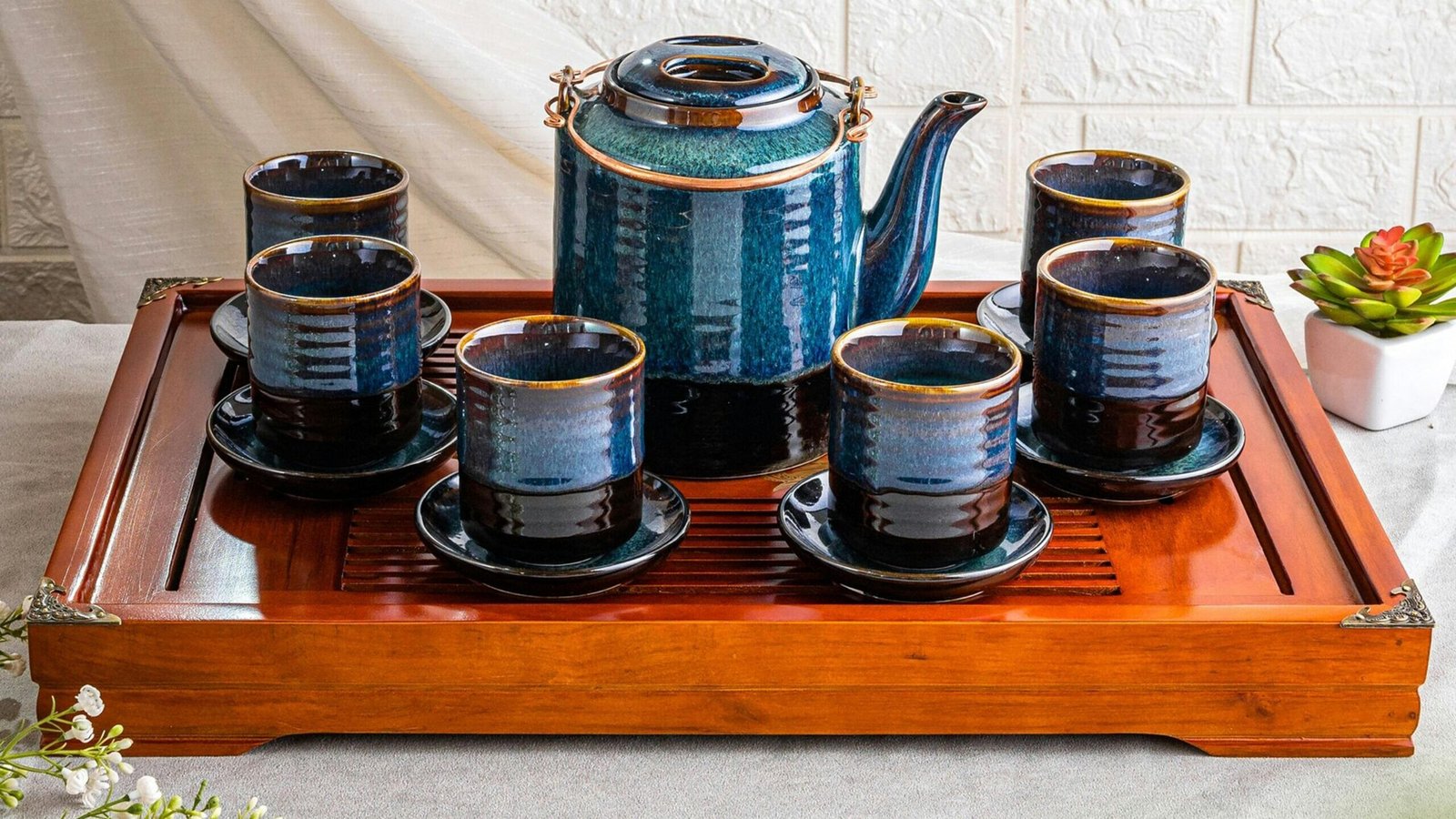
Tea trays serve as the foundation of any proper tea setup, known in Chinese as “Chaban.” This term describes the platform where all tea tools and utensils rest during brewing sessions.
The two main types include Cha Pan, which features drainage systems for “wet” brewing styles, and Cha Chuan, often called a “tea boat” that holds single vessels. Both styles play vital roles in Gongfu tea ceremonies by catching spills and rinse water.
Chinese tea culture values these trays not just as practical items but as artistic expressions. A quality bamboo or wooden tray enhances the tea experience through both function and beauty.
Many tea drinkers choose trays based on material, size, and drainage features to match their brewing style. The right tray creates a tidy, elegant space that transforms simple tea drinking into a complete sensory ritual.
Core Functions: Beyond a Simple Platform
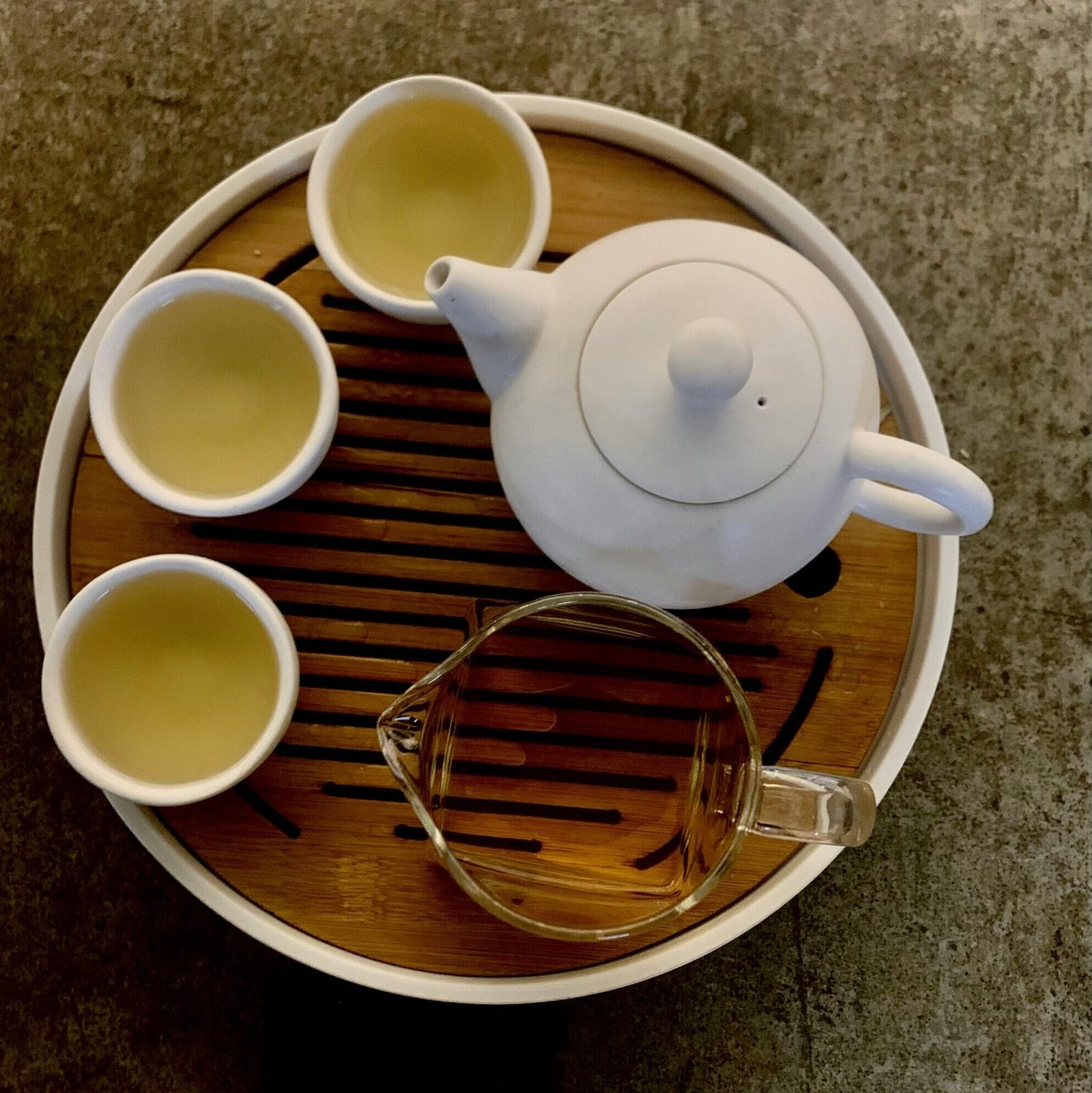
Moving beyond the basic definitions of Cha Pan and Cha Chuan, tea trays serve crucial functions that transform the brewing experience. A quality tea tray does much more than hold your teapot and cups – it creates a complete brewing system.
The built-in drainage channels manage spills and excess water, keeping your tea session neat and organized. This drainage feature proves essential during gongfu ceremonies where multiple infusions create splashes and overflow.
The reservoir beneath captures waste water, allowing you to focus on the brewing process rather than worrying about messes.
Tea trays also function as organizational hubs for your brewing tools. Many designs include specific areas for teapots, cups, and utensils, making the brewing process more efficient.
The flat surface provides stability for delicate porcelain or ceramic pieces, preventing accidents during serving. Beyond these practical benefits, a well-crafted bamboo or wooden tray adds visual appeal to your tea ritual.
The blend of utility and beauty makes these trays centerpieces that elevate simple tea drinking into a refined cultural practice. The sturdy construction of quality trays ensures they remain functional through years of daily use.
Importance in “Wet” Brewing and Gongfu Cha
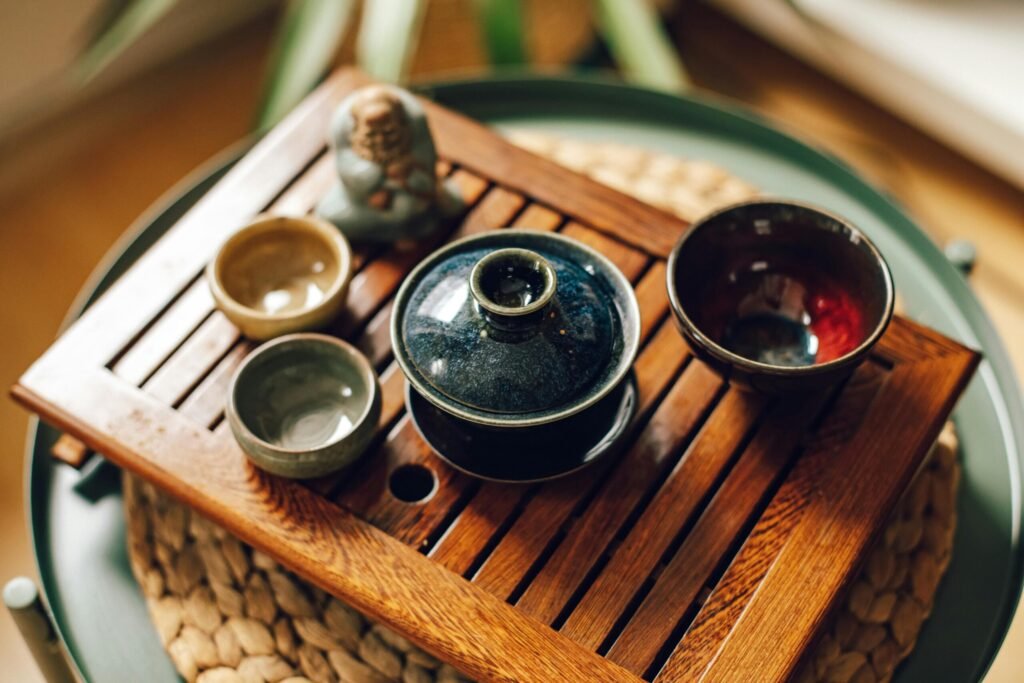
Tea trays serve a vital role in gongfu tea ceremonies where “wet” brewing happens. During this process, hot water splashes as you rinse teaware and pour multiple short infusions. A good tea tray catches this excess water through its drainage system, keeping your desk or table dry.
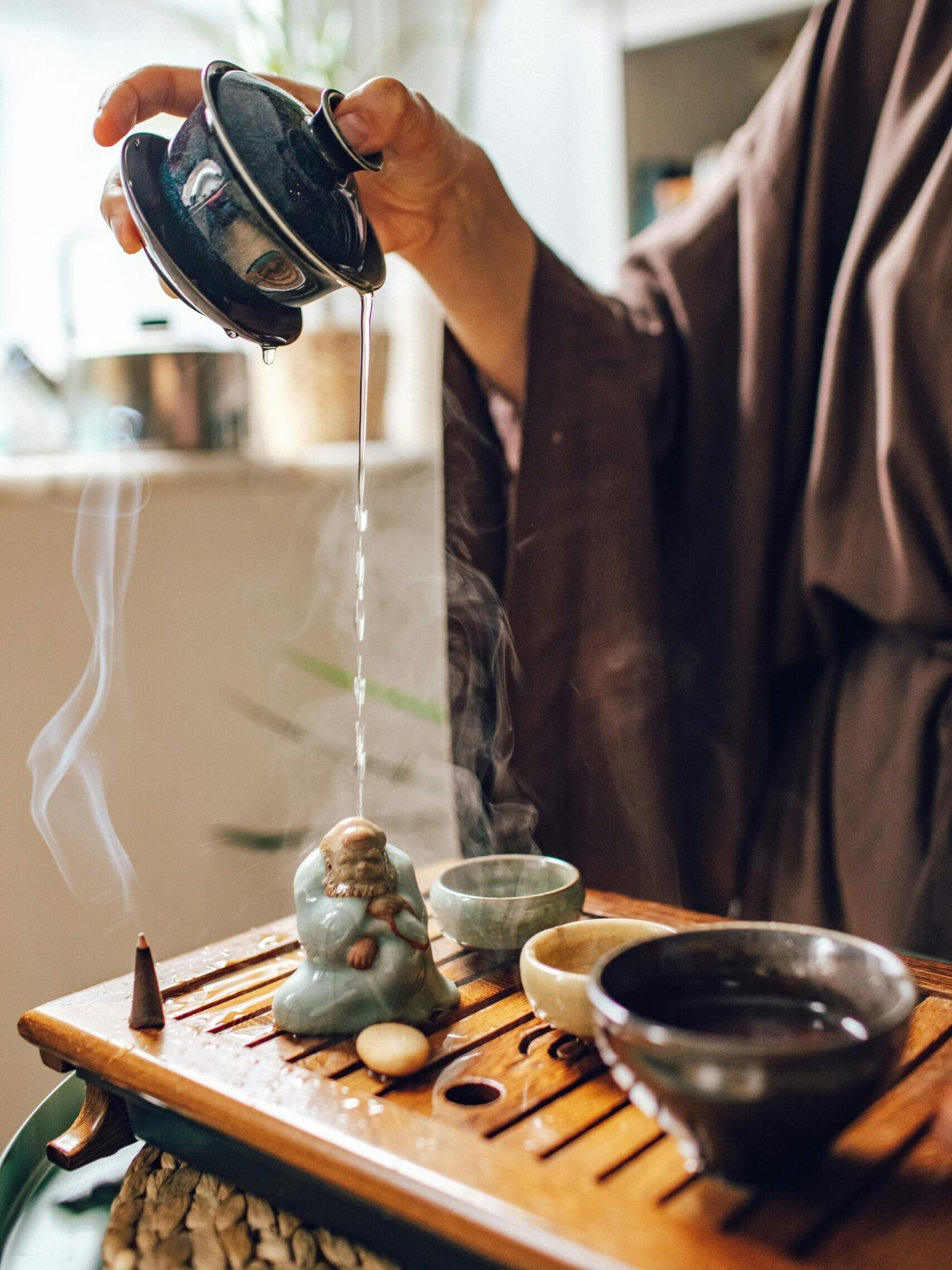
Bamboo and wooden trays excel here because they handle moisture well while adding natural beauty to your tea setup.
Gongfu cha demands precision with water temperatures between 195°F to 205°F, making a proper draining tray essential equipment alongside gaiwans and teapots. The tray creates a dedicated space for your brewing ritual, allowing you to focus on extracting the tea’s full character through careful steeping.
Many tea enthusiasts choose large trays with detachable reservoirs for extended sessions, making cleanup simple after exploring all the subtle flavors each infusion reveals.
Exploring Tea Tray Designs and Construction
Tea trays range from basic flat surfaces to complex designs with built-in drainage systems. Each style serves a purpose – from catching spills on simple platforms to managing water flow through hidden chambers in more elaborate models.
Simple Surfaces vs. Elaborate Constructions

Tea trays range from basic to complex designs to suit different brewing needs. Simple surfaces feature round or square shapes that hold your teapot and cups without extra features.
These straightforward designs work well for casual tea sessions and minimal setups. The Sea Leaf Round Wooden Tray offers a beautiful base for morning tea essentials while maintaining a clean aesthetic.
Elaborate constructions include double-layered trays with built-in drainage systems for gongfu brewing. These advanced trays catch spilled water through slats or holes that direct liquid to a hidden reservoir below.
Bamboo remains the most practical material for these complex designs, while stone trays provide great durability. Many elaborate trays feature decorative motifs, waterproof finishes, and even drawers for storing tea tools.
Understanding Reservoirs and Drainage Systems
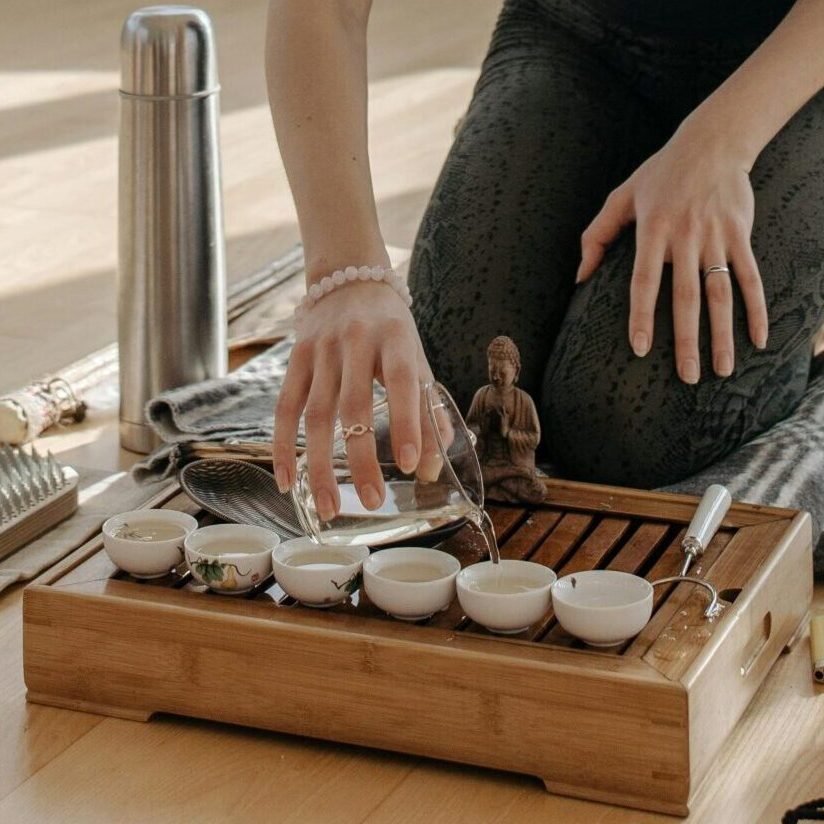
Tea trays with reservoirs serve a crucial purpose beyond simply holding your teaware. Most quality trays feature a dual-use drainage system that collects waste water during brewing sessions.
This smart design includes a hidden large-capacity water storing tank that keeps spills contained until you’re ready to dispose of the collected water. Bamboo and wooden trays often incorporate these systems through slotted surfaces that allow liquid to flow into a removable basin below, making them practical for gongfu tea ceremonies where multiple infusions create excess water.
The drainage system enhances the overall functionality for tea enthusiasts who practice “wet” brewing styles. Many modern designs allow the tray to disassemble into three pieces for easy cleaning and maintenance.
This feature proves especially valuable with natural materials like bamboo that require proper drying to prevent mold growth. Stone and porcelain trays might use different drainage approaches, sometimes featuring subtle channels that direct water to a specific collection point.
The best systems balance water capacity with a sleek, unobtrusive design that doesn’t distract from your beautiful teaware.
A Guide to Common Tea Tray Materials

Tea trays come in many materials, each with special traits that match different brewing styles and settings. We’ll explore the most common options from classic bamboo to modern metal, helping you find the right match for your tea practice.
Bamboo: The Popular and Practical Choice
Bamboo stands as the top choice for tea trays due to its perfect blend of beauty and function. These natural trays hold an impressive 2100 ml of water, making them ideal for Gongfu tea ceremonies where spills happen often.
The lightweight yet sturdy bamboo construction weighs just 1.2 kg, allowing for easy movement between kitchen, dining room, or outdoor spaces. Many tea lovers prefer bamboo for its renewable qualities and natural grain patterns that enhance the tea ritual experience.
Available in convenient sizes like 30 cm square (11.8 inches) or 33 cm square (13 inches), bamboo trays fit most tea settings without taking up too much space. The material naturally resists water damage while developing a unique patina over time that tells the story of your tea journey.
Bamboo trays strike the right balance between traditional craftsmanship and modern practicality, making them a smart investment for both casual tea drinkers and serious enthusiasts.
Wooden Trays: Aesthetics and Durability

Wooden tea trays bring natural warmth and elegance to any tea session. Made from materials like walnut or bamboo, these trays showcase unique grain patterns that develop character over time.
They serve dual purposes as both storage solutions and serving platforms, making them practical choices for daily tea drinkers. The natural wood finish creates a perfect backdrop for porcelain teacups and metal accessories.
Proper care extends the life of wooden tea trays despite their exposure to moisture. Users must dry them thoroughly after each use to prevent warping or cracking issues common with wood products.
Many handmade wooden trays feature built-in drainage systems that collect excess water during gongfu ceremonies. This smart design element protects both the tray and your furniture while maintaining the tray’s beautiful appearance through years of tea service.
Stone Trays: Stability and Natural Beauty
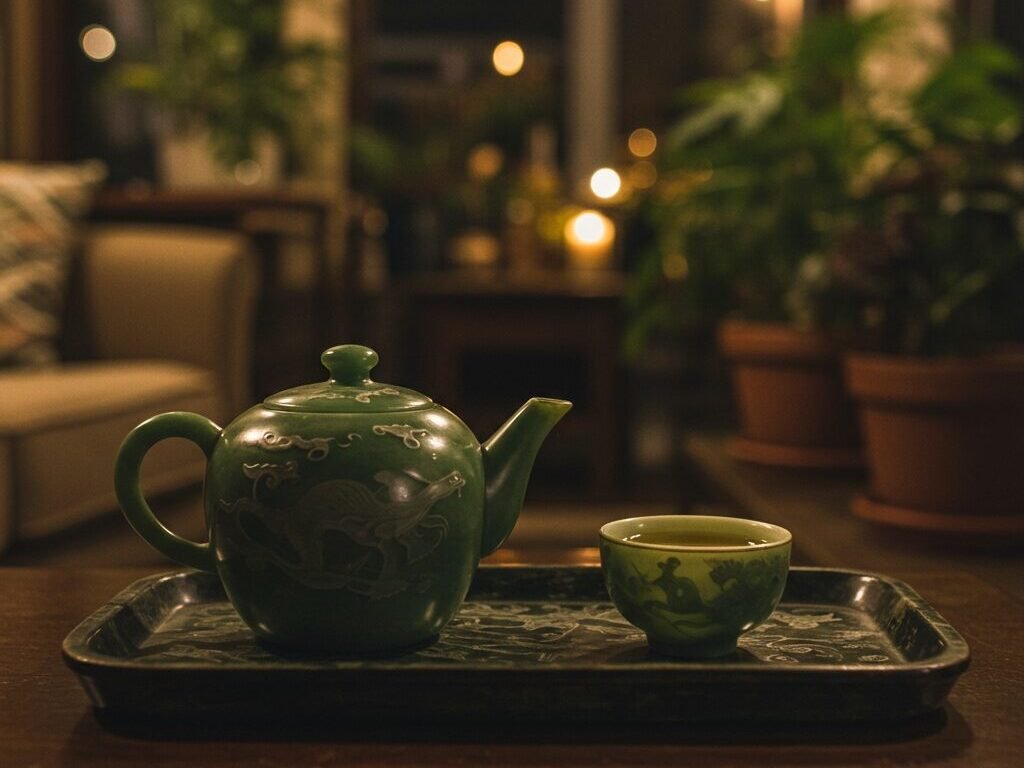
Stone tea trays, although very rare, bring natural elegance to your tea ritual with their solid construction and unique patterns. Tianluo green stone stands out as a top choice for tea enthusiasts who value both function and beauty.
These trays offer unmatched stability during tea ceremonies, preventing accidental spills even on uneven surfaces. The smooth surface makes cleaning simple – just wipe with a damp cloth after use.
Tea lovers appreciate stone trays in various sizes to match different needs. From compact 50*30*3cm models perfect for personal sessions to spacious 70*40*3cm versions ideal for group gatherings, these trays adapt to any setting.
Despite their solid appearance, many stone trays like the Tianluo green stone weigh only about 50 grams, making them surprisingly portable. Each tray showcases nature’s artistry through unique mineral patterns and color variations that develop character over time, creating a stunning backdrop for your teaware collection.
Porcelain Trays: Elegance and Coordination
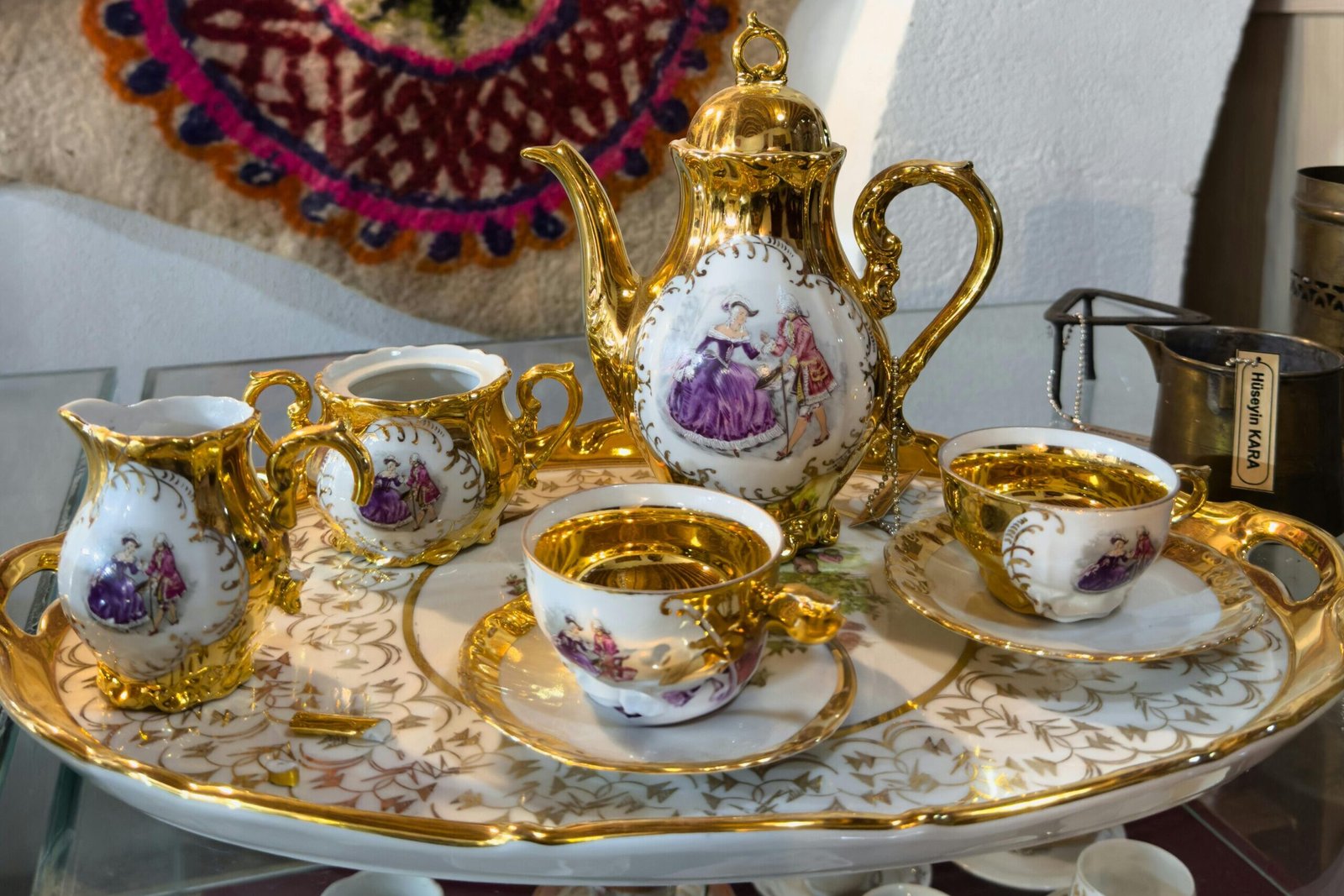
Porcelain tea trays stand out for their smooth, glossy surfaces that add a touch of refinement to any tea setting. These white porcelain pieces often feature delicate designs or simple, clean lines that match well with most teaware collections.
Many tea lovers choose porcelain trays because they resist stains and clean up easily after tea sessions. The non-porous surface prevents absorption of tea liquids, making these trays practical for daily use despite their elegant appearance.
Fine porcelain trays create a striking backdrop for colorful teas and can elevate an afternoon tea experience from casual to sophisticated. The material’s durability surprises many first-time buyers who expect fragility.
Modern porcelain trays come with smart drainage systems that direct spills away from your tea space. Tea houses often select these trays for their classic look and ability to coordinate with various tea cups, pitchers, and accessories across different serving styles.
Metal Trays: Modern and Traditional Uses
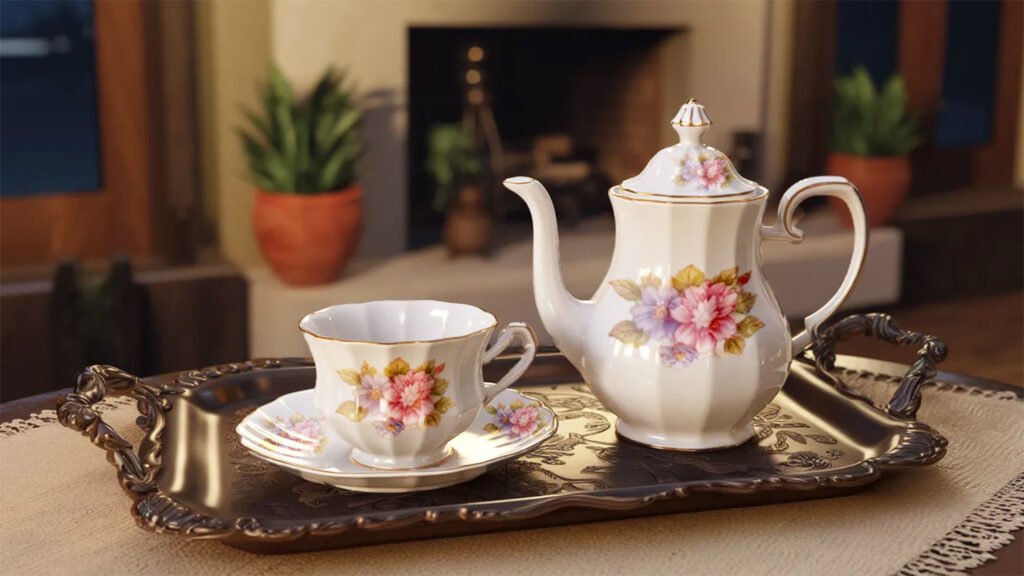
Metal tea trays blend modern style with traditional function in today’s tea culture. Brass and copper trays shine in Moroccan tea services, where their ornate designs showcase skilled craftsmanship.
Silver trays appear in formal British tea settings, adding elegance to afternoon gatherings. Modern stainless steel options offer durability and easy cleaning for daily use, making them popular in busy teahouses and homes alike.
Some metal trays feature intricate drainage systems that collect excess water through small holes or channels.
Many tea enthusiasts appreciate how metal trays develop character over time. Copper and brass develop a rich patina that tells the story of countless tea sessions. Steel trays resist staining and maintain their appearance with minimal care, perfect for serving herbal tea or fine tea varieties.
The cool surface of metal can help regulate tea temperature during summer months, an unexpected benefit many tea lovers discover. Sustainable material trends now influence metal tray production, with recycled metals becoming increasingly common in eco-conscious tea ware collections.
Next, we’ll explore the practical considerations for using and caring for your tea tray regardless of material choice.
Sustainable Material Trends in Tray Production
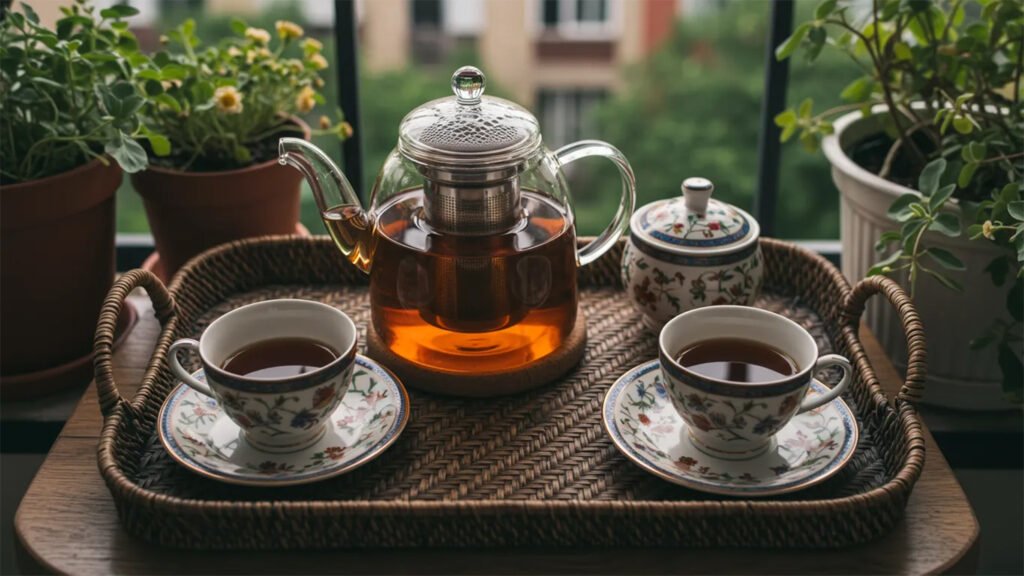
Tea lovers now focus more on eco-friendly materials for their brewing gear. Bamboo leads this green movement as a fast-growing, renewable resource that creates lightweight yet sturdy trays.
Many tea enthusiasts choose bamboo for its natural beauty and small environmental footprint compared to traditional hardwoods.
Beyond bamboo, Black Sandalwood from sustainable forests offers an earth-friendly option with rich, warm tones. Resin trays, while pricier, last for years without replacement, reducing waste over time.
This shift toward green materials matches the mindful nature of tea culture itself. The best sustainable trays balance durability with minimal environmental impact, giving tea drinkers beautiful tools that align with their values.
Cultural Significance and Regional Tray Styles

Tea trays carry deep cultural meaning across different regions, from Chinese Gongfu ceremonies to Moroccan hospitality customs, each with unique designs that tell stories of tradition and craftsmanship – discover how these beautiful serving platforms connect us to ancient tea rituals and modern tea enjoyment.
The Tea Tray in Chinese Gongfu Ceremonies
Tea trays serve as the foundation of Chinese Gongfu ceremonies, playing both practical and symbolic roles. The Cha Pan, with its built-in drainage system, catches excess water during the “wet brewing” process that defines these rituals.
Chinese tea masters place their brewing vessels, cups, and tools on these platforms, creating a contained space for the ceremony to unfold. Many trays feature hand-painted designs of bamboo or pomegranates, symbols that represent resilience and good fortune in Chinese culture.
Gongfu ceremonies demand proper tea tray selection based on the brewing style and number of guests. The simpler Hu Cheng works for dry brewing methods, while the drainage-equipped Cha Pan proves essential for traditional wet brewing techniques.
Tea enthusiasts value these trays not just as functional items but as artistic expressions that connect them to centuries of tea tradition. Regular cleaning prevents mold growth and maintains the natural beauty of bamboo, wood, or ceramic materials commonly used in these ceremonial accessories.
The Art of Patina: Intentional Staining in Yixing Traditions
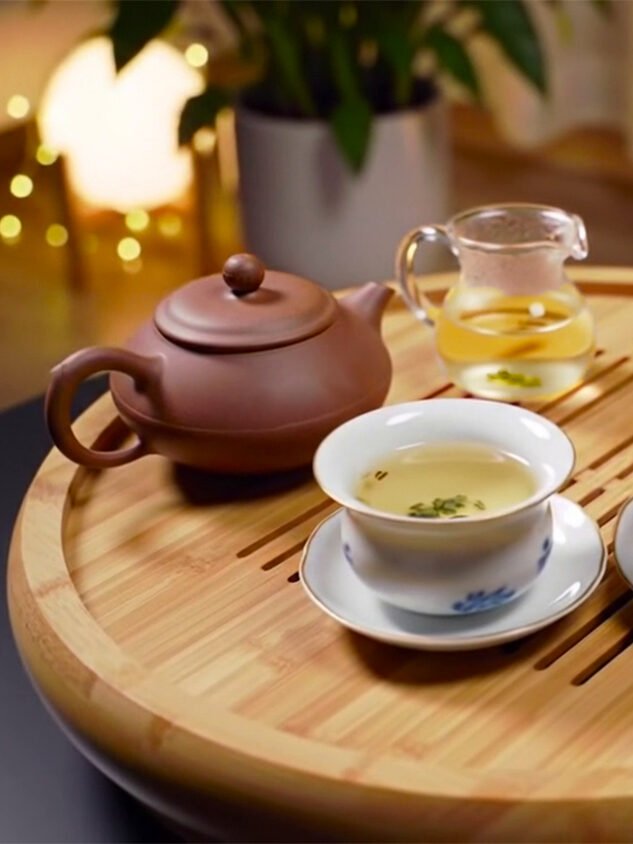
Chinese gongfu ceremonies showcase tea trays as central pieces, but Yixing pottery brings its own special tradition through patina development. This natural staining process happens differently for each pot – some develop rich colors within weeks while others take months or never show much change.
Master craftsman Gu Jing Zhou refined these techniques, creating pots that respond uniquely to hot water. At room temperature, quality Yixing clay resists moisture, but once heated to 90-95 degrees Celsius, it becomes more receptive to water and tea oils.
The bamboo or wooden tea tray serves as the perfect stage for this natural art form. Many tea enthusiasts value this patina as proof of a well-loved teapot rather than something to scrub away.
The natural staining creates a unique finish that tells the story of countless brewing sessions. Each pour of tea adds another layer to the pot’s character, making every Yixing vessel truly one-of-a-kind and deeply personal to its owner.
Moroccan Tea Trays: Craftsmanship and Hospitality
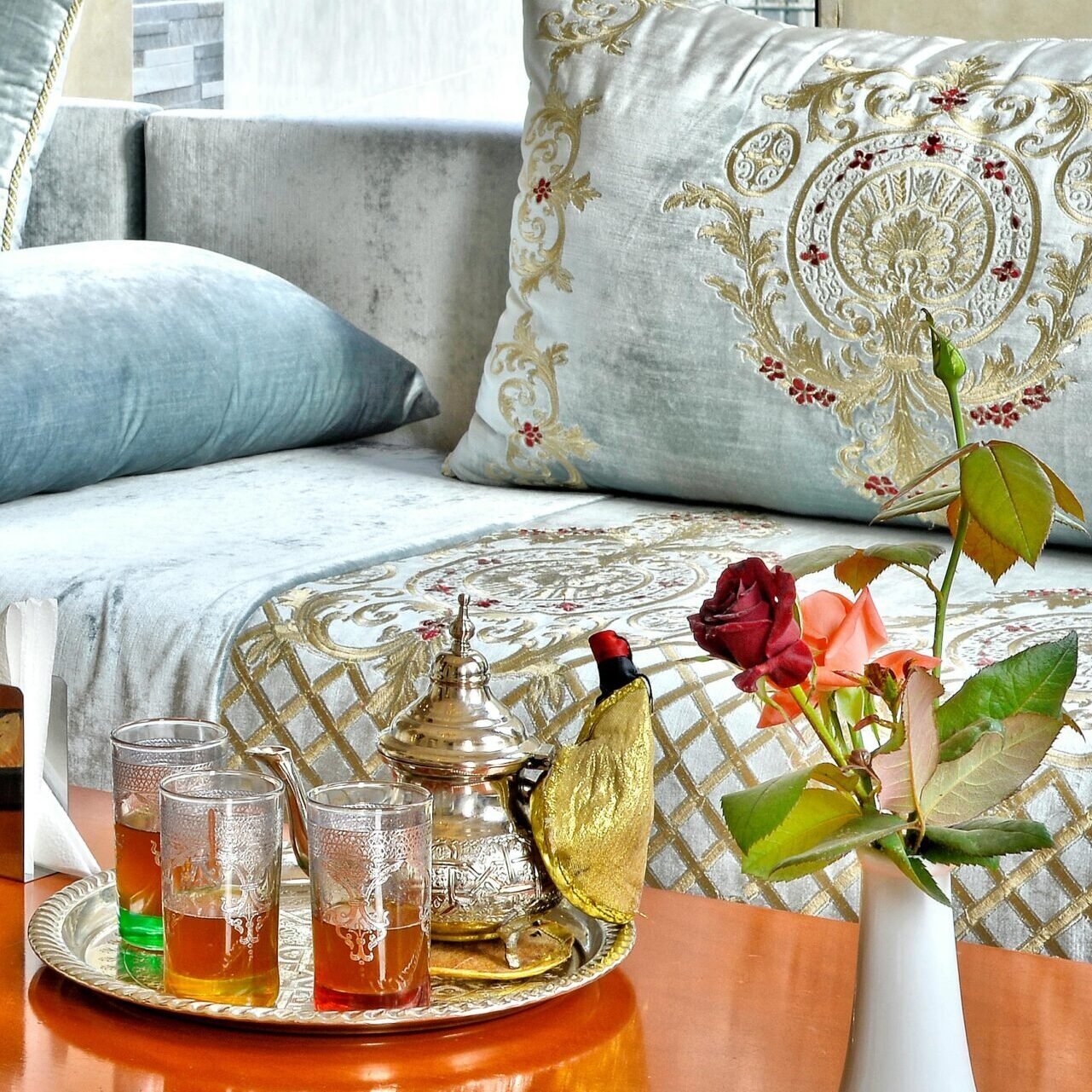
Moroccan tea trays stand as beautiful symbols of welcome in North African culture. These stunning serving platforms blend art with function through intricate metalwork, carved wood, or painted ceramics.
Artisans craft each tray with geometric patterns, floral designs, and Arabic script that tell stories of regional heritage. The large, round shape of traditional trays allows hosts to present mint tea with style during social gatherings.
Tea service in Morocco goes beyond simple refreshment to become a ritual of friendship. The act of pouring mint tea from decorative pots onto a handcrafted tray shows care for guests.
Many families pass down these metal or wooden trays through generations as treasured items. Modern tea lovers appreciate both the practical aspects and cultural significance of these durable, easy-to-clean serving pieces that transform daily tea drinking into a special event.
Practical Considerations: Using and Caring for Your Tea Tray
Tea trays serve as the foundation of your tea ritual, collecting spills and supporting your teaware. Proper care extends the life of your tray and maintains its beauty through years of tea sessions.

Daily Care & Cleaning
- Clean with dry gauze after each use – You’ll want to wipe down your tray with soft, dry gauze rather than soaking it in water, which preserves the natural finish
- Empty the reservoir promptly – Clear the drainage system after every tea session to prevent mold growth and unpleasant odors
- Wipe spills immediately – Natural bamboo surfaces stain easily, so you should clean any tea drips right away
- Check drain holes regularly – A quick inspection ensures tea leaves and debris won’t clog your drainage system

Long-term Maintenance & Protection
- Shield from direct sunlight – Prolonged sun exposure causes warping and fades the natural color of bamboo and wooden trays
- Control humidity levels – Wooden surfaces crack in dry environments, so maintaining moderate humidity extends your tray’s lifespan
- Apply food-grade mineral oil – We recommend treating wooden trays every 2-3 months to preserve their natural luster and prevent drying
- Polish metal trays appropriately – Specific metal cleaners maintain shine and prevent tarnishing on stainless steel or copper surfaces
- Rotate tray position during use – This simple practice ensures even patina development across the entire surface
- Monthly wear inspections – Regular checks catch water damage or wear issues before they become major problems
Storage & Setup Tips
- Store upright when not in use – Vertical storage allows complete air drying and prevents moisture buildup
- Use tea towels under hot teapots – This extra layer protects delicate surfaces from heat damage
- Place waterproof mats beneath bamboo trays – Your furniture stays protected from any moisture that might seep through
- Choose appropriate sizes for your space – Mini tea trays offer full functionality in compact areas without crowding your tea table
- Handle porcelain trays with care – These elegant pieces crack under heavy tea accessories, so we suggest using them for lighter tea ware
Conclusion

Choosing the right tea tray transforms your daily ritual from simple to special. A well-crafted bamboo, wood, or porcelain tray serves both function and beauty in your brewing process.
Your selection should match your brewing style, whether you prefer gongfu methods with their water-rich process or a simpler Western approach. Regular care keeps your tray looking great and extends its life for years of enjoyment.
The perfect tray waits for you, ready to become the foundation of countless peaceful moments spent with your favorite drink.
For an even more refined tea experience, explore our selection of high-quality tea infusers.
FAQs
1. What makes a tea tray stylish and functional?
A stylish tea tray combines beauty with function. The best ones feature a water drain system to catch drips during your tea ceremony. They often come with a metal top or plastic surface that’s easy to clean after serving.
2. Can I use my tea serving tray for other purposes?
Absolutely! Your tea tray works great as a charcuterie board or accent piece when not in use for drink tea. Many people repurpose their large tea trays as decorative table accessories between tea times.
3. What materials are best for quality tea trays?
Traditional tea trays from China often feature bamboo or wood with a special coating to drain water effectively. Modern options include plastic and metal varieties that offer durability for those who enjoy tea every day. The material you choose should match your specific needs and aesthetic preferences.
4. How do I properly maintain my gongfu tea set tray?
Clean your tray after each use by wiping it with a damp cloth. For trays with a drain system, make sure to empty the water collection area regularly. Wooden trays benefit from occasional oiling to prevent drying and cracking.
5. What should I look for when buying a tea table or tray?
Look for a tray without weak joints that can handle the weight of your complete tea set including bowl and saucer. Consider size based on your typical serving needs and storage space. A good tea tray should feel solid, drain properly, and complement your cool tea accessories.
References
- https://teaflowusa.com/blogs/journal/chaban-tea-tray-hucheng-chachuan-and-other-variants-of-tea-trays (2023-06-21)
- https://teatsy.com/blogs/blog/chinese-tea-tray?srsltid=AfmBOorV_VJd0ORjVJuHwfjPFrrhEA884xirXH1Bv1RisJ6bTQhJ_v6U (2024-09-13)
- https://white2tea.com/blogs/blog/how-to-brew-gongfu-style-an-expert-guide-to-making-tea (2024-04-10)
- https://www.umiteasets.com/collections/tea-tray?srsltid=AfmBOoqHFqWxijawfXWMaLKDmHLQxvTot04M0gbmBX_YsEWNquMXnQb6
- https://www.amazon.com/Tea-Talent-Reservoir-Drainage-Solid/dp/B01G1BH8CY
- https://www.amazon.com/Tray-Tea-Chinese-Japanese-Serving-Storage/dp/B0DSLFW1FF
- https://chineseteastory.com/project/how-to-choose-the-perfect-tea-tray/
- https://www.amazon.com/Natural-Tianluo-Original-Household-Simple/dp/B0DXFFN75J
- https://www.umiteasets.com/collections/tea-tray?srsltid=AfmBOooYcHA_mWT-vx9xH8WZd5oV-dWoylfAFNjoNoBX5_GPqUlBN7eI
- https://www.admiringazeland.com/tea-tray-c139316/
- https://www.heychina.com/pc/chinese-tea/teaware-accessories/tea-trays/
- https://www.kyarazen.com/patina-development-of-yixing-pots/
- https://assendelft.co.za/posts/moroccan-tea-tray/
- https://www.teavivre.com/info/classification-and-use-of-tea-trays.html?srsltid=AfmBOoq0jDbYWbuhCEDItR3ljMgOacSOR1NGLCIEFRPg6Uh0zuuSX2ck







